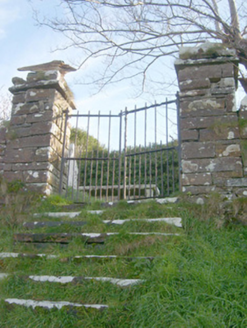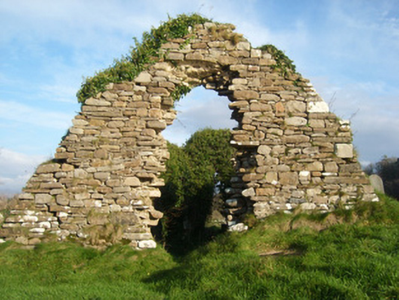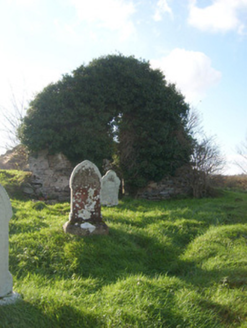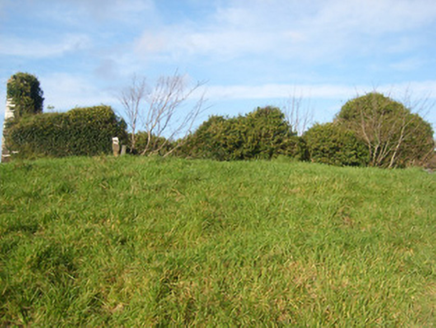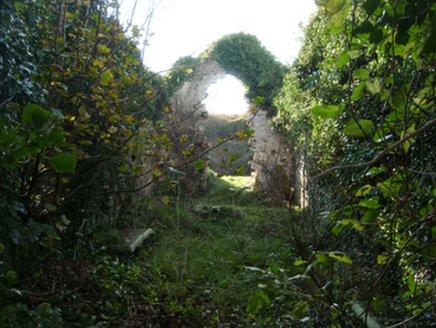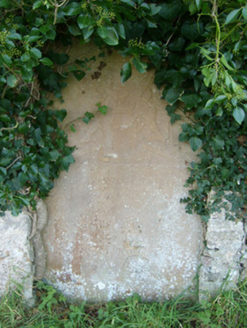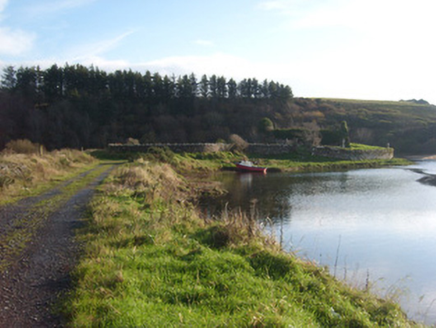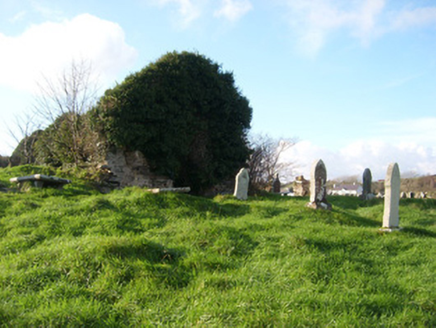Survey Data
Reg No
40909826
Rating
Regional
Categories of Special Interest
Archaeological, Architectural, Historical
Previous Name
St. Naul's Church of Ireland Church
Original Use
Graveyard/cemetery
Date
1600 - 1700
Coordinates
181944, 377666
Date Recorded
23/11/2007
Date Updated
--/--/--
Description
Remains of former Church of Ireland church, on rectangular-plan, built c. 1610, now ruinous and out of use (remained in use until 1807). Possibly containing fabric of earlier church or churches to site. Roof now collapsed, originally pitched thatch roof, later slated. Remains of chamfered cut stone eaves cornice, added c. 1750. Rubble stone construction with buttress to the north-west corner; walls now largely covered in ivy/vegetation. Cut stone plaque/memorial with carved coat of arms of Hume family and inscription reading ‘True to the End’ and dated 1751 to the north-west wall. Round-headed window openings to gable ends, now much denuded. Former openings to the north-west and south-east elevation now denuded and covered in vegetation. Round-headed doorway to the west end of the north wall, now blocked, having stone voussoirs to arch, remains of hoodmoulding, and with denuded carved stone head. Set back from road in an elevated site to the south-west of Inver and to the west of Mountcharles. Located on a bend at the mouth of the Eany Water River; site reached along causeway from the west. Graveyard to site having collection of recumbent, upstanding and table-type memorial monuments of mainly nineteenth-century date. Earliest legible memorial dated 1751. Graveyard surrounded by rubble stone boundary wall on irregular-plan, curving along with topography to the south-west, having rubble stone coping over. Gateway to the site comprising a pair of squared rubble stone gate piers (on square-plan) having capstones over, and having a pair of simple wrought-iron gates. Flight of cut stone steps from causeway adjacent to river up to gateway.
Appraisal
The fragmentary remains of this simple church are an important element of the built heritage and social history of the Inver area. This church probably dates to or was heavily modified c. 1610. It was described in 1622 as in ’reasonably good repair’ and having a thatched roof. The present church probably incorporates the remains or fabric an earlier church or churches to site, including a church of late twelfth of early thirteenth-century date. Although apparently originally thatched, this church was slated during the mid-eighteenth century when the eaves cornice was added. This church continued in use until the construction of the new Church of Ireland church at Inver (see 40909203), located a short distance to the north-east, in 1807. The church is surrounded by an elevated graveyard containing a fine collection of cut stone recumbent, upstanding and table-type memorial monuments of mainly nineteenth-century date, some of artistic merit. A number of eighteenth-century memorials also survive to site including one commemorating Thomas Hume, dated 1751, having the Hume family coat-of-arms in bas relief and the inscription ‘True to the End’. These add significantly to the context of this church site, while the simple rubble stone boundary walls and the gateway complete the setting of this interesting composition. This church forms part of a group of related sites with former Church of Ireland rectory (see 40909214) to the north, which was originally built to serve this church, and the Church of Ireland church to the north-east (see 40909203), which was built in 1807 to replace this earlier church. Stunningly set at a bend of the Eany Water River adjacent to Inver Bay, this building makes a strongly positive contribution to the built heritage and history of the local area.
